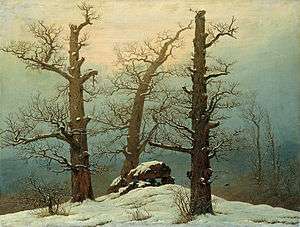Cairn in Snow
| German: Hünengrab im Schnee | |
 | |
| Artist | Caspar David Friedrich |
|---|---|
| Year | 1807 |
| Medium | Oil on canvas |
| Dimensions | 62 cm × 80 cm (24 in × 31 in) |
| Location | Galerie Neue Meister, Dresden |
Cairn in Snow (German: Hünengrab im Schnee) is a landscape painting by Caspar David Friedrich. It was created in 1807. The painting is a Romantic allegorical landscape, showing a pagan burial site between three oaks, near the town Gützkow in Germany. The painter depicts barren trees in the snow, giving the work a haunted, spectral air. The painting with its contemplative melancholy mood is transmitting to us a Romantic view of nature. Trees and forests were seen as symbols of life endurance, longevity and immortality. Sacred groves, often a group of trees in ancient times were associated with secrecy and initiation rites, and they were regarded as untouchable.[1][2] However, the trees depicted by Friedrich looks abandoned and most of the branches chopped off.
Today the painting is in the Galerie Neue Meister in Dresden. It was originally owned by the Greifswald University professor Karl Schildener. The painting is described in 1828 in the Greifswald academical journal (II, 2, pp. 40–41).[3][4] Friedrich is noted for his landscapes depicting features silhouetted against the sky, morning mists or Gothic ruins. This work is one of his earliest oil paintings.
References
- ↑ "Forest and tree symbolism in folklore". www.fao.org. Retrieved October 2014. Check date values in:
|access-date=(help) - ↑ "World tree". global.britannica.com. Retrieved October 2014. Check date values in:
|access-date=(help) - ↑ "Hünengrab im Schnee", Staatliche Kunstsammlung Dresden.
- ↑ Chris Noir, "Caspar David Friedrich", Time Does Not Rest, 29 April 2013.
Further reading
- Friedrich, Caspar David, by Theodor Pyl
- Aschenbeck/Dehnel/Stock, Auf den Spuren von Caspar David Friedrich, Verlag Fischerhude, 1993, ISBN 3-88 132 111-X
